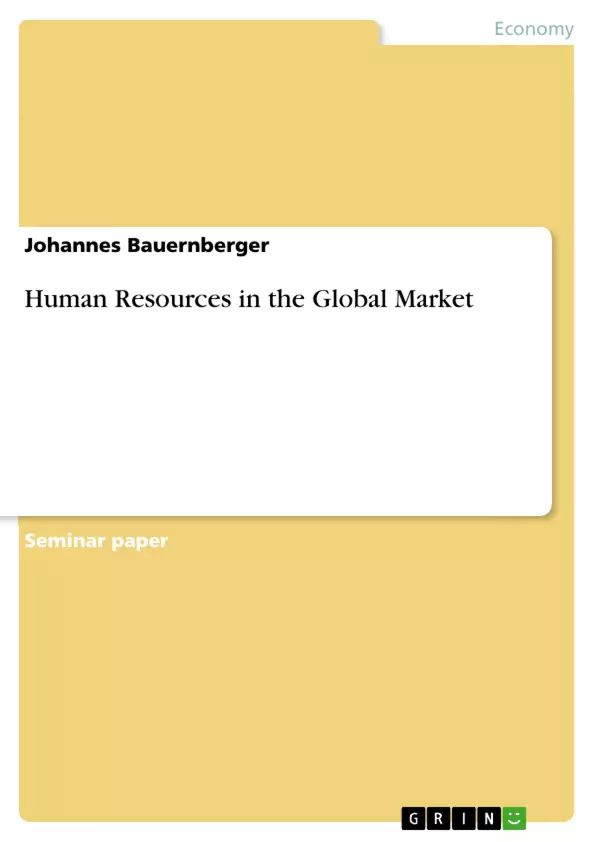Recruitment and selection in International Human Resource Management is crucial; finding the right people to fill key positions can determine a company’s international operation. Furthermore, it is extremely costly for the company if the expatriate fails. The performance of an expatriate is often determined by factors like (in)ability to adjust to foreign culture, the length of the assignment, willingness to move and work-related factors. What should be considered when selecting an expatriate are therefore criteria like technical ability, cross-cultural suitability, family requirements, country requirements as well as language and company requirements. However, recruitment and selection are only the first step for international Human Resource Management.
The aim of this paper is therefore to point out the increasing importance of Human Resource Management especially from internationally operating companies’ point of view. Furthermore, it will be pointed out what International Human Resource Management is and why it is necessary for Multi National Companies (MNCs) to concern about this topic. In addition, challenges and requirements of HRM will be illustrated and highlighted.
This work will furthermore portray the recruitment and selection process as well as the necessity of training and development within global companies. It will describe the workplace conflict and deal with subjects such as industrial relations and employment law.
Table of Contents
- 2. STRATEGIC HUMAN RESOURCE MANAGEMENT AND THE INTERNATIONAL MARKETS
- 2.1 Introduction.
- 2.2 International Human Resource Management.
- 2.3 The importance of HRM for firms operating in international markets.
- 3. RECRUITMENT AND SELECTION.
- 3.1 Expatriate failure.
- 3.2 Factors in expatriate selection.
- 4. TRAINING AND DEVELOPMENT
- 4.1 Definition and overview of traditional training and development.
- 4.2 The effect of Globalisation on Human Resource Management
- 4.3 Training and development and international assignments
- 5. WORKPLACE CONFLICT AND NEGOTIATIONS
- 5.1 Classifications of conflict and conflict management.
- 5.2 How to handle conflict/picking the right style:
- 6. PERFORMANCE MANAGEMENT IN INTERNATIONAL HRM
- 6.1 Multinational Performance Management.
- 6.2 International employees and Performance Management.
- 6.3 Performance appraisal of international employees.
- 6.4 Appraisal of HCN employees.
- 7. INDUSTRIAL RELATIONS AND EMPLOYMENT LAW
- 7.1 International Industrial Relation.
- 7.2 Collective Bargaining.
- 7.3 Industrial Relation History.
- 7.4 International Human Resource Management Strategies for entering into the Global Market.
Objectives and Key Themes
This paper aims to highlight the growing importance of Human Resource Management, particularly from the perspective of internationally operating companies. It explores the concept of International Human Resource Management (IHRM) and emphasizes its necessity for Multinational Companies (MNCs). Additionally, the paper sheds light on the challenges and requirements of HRM in a global context. It further analyzes the recruitment and selection process, as well as the significance of training and development within international corporations. Moreover, the paper delves into the topic of workplace conflict and discusses subjects such as industrial relations and employment law.
- The Importance of IHRM for MNCs.
- Challenges and Requirements of HRM in a Globalized World.
- Recruitment and Selection in IHRM.
- Training and Development in a Global Context.
- Workplace Conflict and Its Management.
Chapter Summaries
The second chapter of this paper introduces the concept of strategic Human Resource Management (HRM) in a global context. It highlights the increasing importance of HRM for companies operating internationally and examines the role of IHRM for multinational corporations.
Chapter three focuses on the crucial aspects of recruitment and selection in IHRM. It discusses the challenges of expatriate failure, examining factors influencing expatriate success and failure. This chapter outlines key considerations for selecting expatriate candidates, encompassing technical skills, cross-cultural suitability, family requirements, and country-specific regulations.
Chapter four explores the vital role of training and development within international companies. It defines traditional training and development, examining its relevance in a globalized context. This chapter highlights the significance of international assignments in fostering management and organizational development and emphasizes the importance of cultural awareness training for successful expatriate assignments.
Chapter five delves into the complexities of workplace conflict and its management in IHRM. It explores different classifications of conflict and various conflict management strategies. This chapter emphasizes the importance of identifying the root causes of conflict and selecting appropriate conflict resolution styles based on the situation and managerial perspective.
Chapter six examines the multifaceted aspect of performance management in IHRM. It discusses how organizational goals are communicated and integrated into departmental and individual objectives. This chapter addresses potential challenges in performance management in a global setting, considering diverse cultural contexts and operational differences. It highlights the importance of cross-cultural training for expatriate managers and recommends a combined approach using hard, soft, and contextual goals for performance appraisal.
The seventh chapter examines the significance of industrial relations and employment law in IHRM. It emphasizes the crucial role of industrial relations in ensuring compliance with legal frameworks governing employment and employee management. This chapter delves into the legal aspects of hiring, maintaining, and terminating employees, including contracts, working hours, wages, bonuses, and other terms and conditions of employment.
Keywords
This paper centers around the key themes of International Human Resource Management, Expatriate Management, Recruitment and Selection, Training and Development, Workplace Conflict, Industrial Relations, and Employment Law. It explores the challenges and opportunities associated with managing human resources in a globalized context and provides insights into the practices and strategies employed by multinational companies to effectively navigate these complexities.
- Citar trabajo
- Johannes Bauernberger (Autor), 2005, Human Resources in the Global Market, Múnich, GRIN Verlag, https://www.grin.com/document/70113



